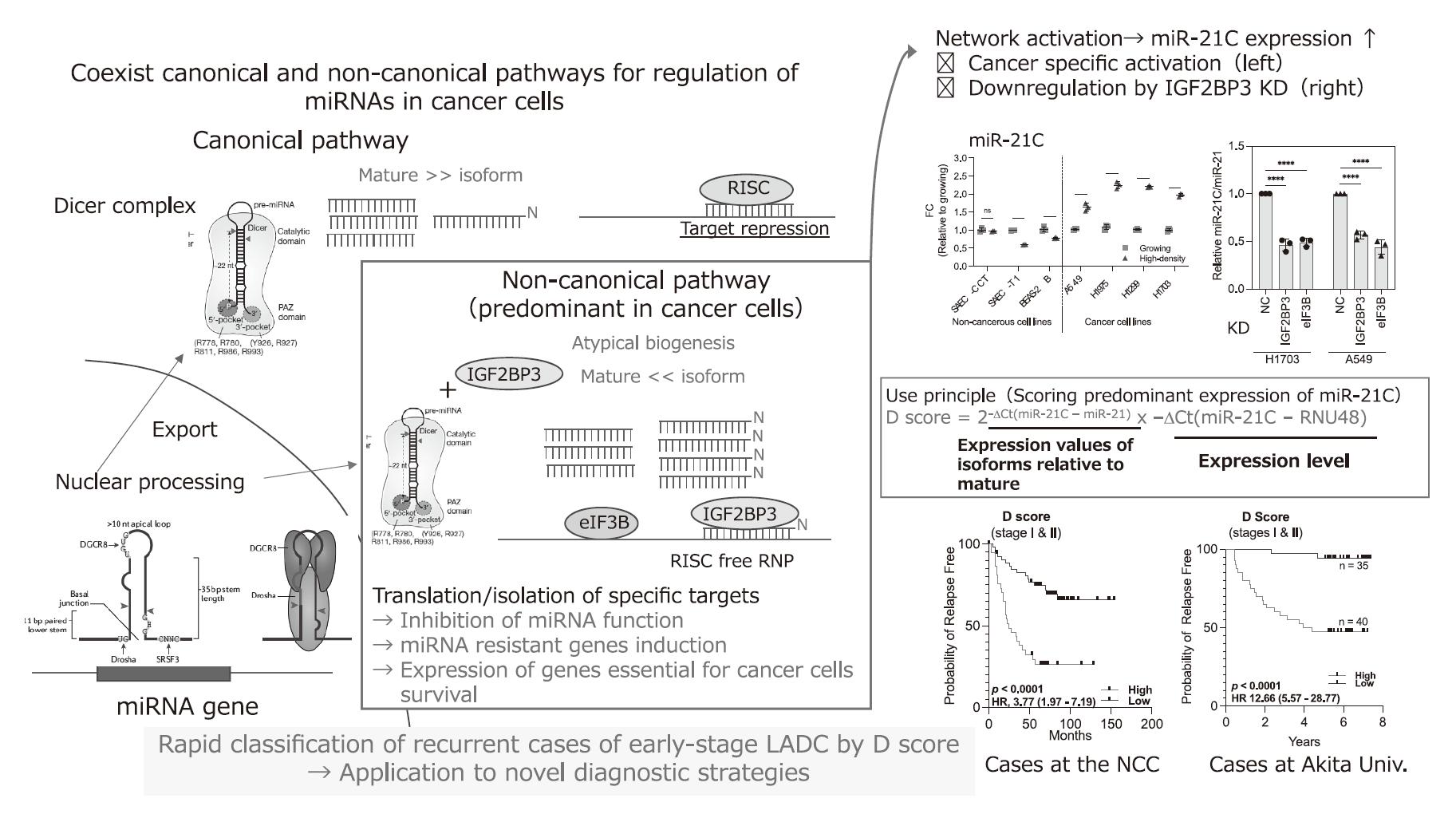Annual Report 2022
Laboratory of Molecular Carcinogenesis
Naoto Tsuchiya, Yuko Fujiwara, Takahiro Shirai, Takumi Yamada, Hayato Mikuni, Yumi Miyamoto
Introduction
To understand the nature of cancer, it is essential to clarify the network structures that are established during the carcinogenesis process. Our research unit is conducting fundamental research to elucidate the intracellular network formed in cancer cells by analyzing non-coding RNAs and to establish new strategies for cancer therapy and diagnosis by analyzing cellular, animal, and surgical specimens.
Research Activities
(1) Understanding a novel miRNA regulatory pathway and its application as a diagnostic biomarker
Our research unit is conducting fundamental research to understand the overall mechanism of gene expression regulated by miRNAs, to elucidate how cancer-specific gene expression profiles are established, and to apply this principle as a novel strategy in cancer medicine. In this fiscal year, we revealed that the expression dominance score of specific miRNA structural isoforms can stratify the risk group for recurrence of early-stage non-small cell lung cancer with high sensitivity. The dominance score can identify malignant characteristics of tumors as a molecular background, such as a high rate of single nucleotide variation (SNV) due to the progression of DNA replication and chromosome segregation, an epithelial-mesenchymal transition (EMT)-oriented gene expression signature, and an immune-evading tumor-microenvironment (TME). Furthermore, we identified IGF2BP3, an oncofetal and multifunctional RNA-binding protein, as a regulator of the dominance score, and revealed IGF2BP3 as one of the factors that regulate miRNA isoform biogenesis. Our results indicate that IGF2BP3 expression in cancer cells induces an oncogenic switch of intracellular miRNAs through the regulation of isoform production and contributes to establishing cell-specific gene expression profiles in cancer cells (Figure 1).
The results of this study are expected to be useful not only for elucidating the nature of cancer, but also for clinical applications. In particular, the predominance score, which can predict recurrence in patients with early-stage lung cancer, has a high negative predictive value of 94%, which may help reduce excessive postoperative medical treatment. To put this principle into practice, we have started applied research in collaboration with a company.

(2) Regulation of tumor cells and tumor-microenvironment by miRNA secretion
Cancer cells secrete various factors to adapt to the surrounding microenvironment. miRNAs, which are incorporated in extracellular vesicles, etc., are released from cancer cells and are essential for maintaining tumor characteristics by regulating surrounding non-tumor cells. On the other hand, cancer cells are thought to secrete specific miRNAs to induce changes in their own gene expression profiles and maintain the malignant traits of the cell. We found that sarcoma cells may induce metastasis by secreting specific miRNAs when they are in a low nutritional state. In other words, the secretion of specific miRNAs may contribute to the malignant phenotype of tumor cells. We identified CMTM6, known as a factor recycling of immune-related molecules, such as PD-L1, as an intracellular target of secreting miRNA and analyzed its detailed function. Interestingly, CMTM6 is a factor that mediates intracellular trafficking of specific miRNAs and secreted factors. Among them, CMTM6 is a unique molecule that is involved in the intracellular trafficking of proteins that are components of plasma membrane raft structures, is important for the activation of plasma membrane receptor signaling, and also regulates the secretory pathway of signaling molecules. We are also investigating the delivery of nucleic acid drugs targeting this molecule with the aim of applying it to cancer therapeutics.
(3) Development of miRNA-based recurrence prediction markers
We are transferring our technology to a company for practical research.
Education
We are supervising research and presentation skills for graduate students and young scientists.
Future Prospects
The results of this year's study are strongly expected to lead to proposing a new concept of functional abnormalities of miRNA regulatory networks in carcinogenesis. In addition, by applying the principle, it will be possible to develop a rapid and simple diagnostic method that can classify the risk group for the recurrence of early-stage lung adenocarcinoma. Moreover, since activation of a non-canonical pathway strongly reflects tumor characteristics, they can be applied as biomarkers to assist in formulatiing treatment strategies for personalized cancer care. Furthermore, the extremely interesting findings on the significance of extracellular secretion of miRNAs are expected to further develop our understanding of the nature of cancer.
